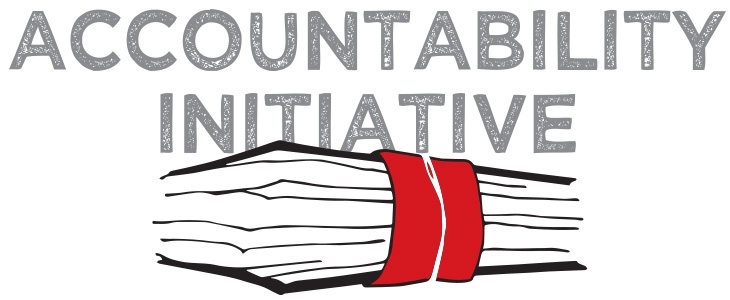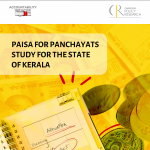
On Data, and its Relationship with Accountability and Transparency
20 October 2009
Notions of transparency and accountability have been evolving since late 1980s. It was advocated that people must be given information about budgets, especially details of heads where money was allocated and how it was spent. This would aid in enforcing transparency, accountability and participation. In the late 1990s, as cities developed, pressure on urban infrastructure increased and municipalities became unable to respond to people’s expectations owing to a variety of reasons. The prevalent view was that municipalities and local politicians are inefficient. Elected representatives were criticized for being corrupt and favouring their vote-banks by distributing city resources to them. It was also believed that use of discretionary powers perpetuates corruption. Contemporary accountability-transparency paradigm is aimed at making transparent to the public how and why discretion is exercised in different circumstances. This (presumably) will curb discretion as much as possible and tighten decision-making.
We need to understand who institutes infrastructure, how much, for whom and who benefits from what. But these issues cannot be raised in the absence of contexts to the data.
Publishing data in public domains as a way to enforce and enhance transparency and accountability has gained greater momentum in the current decade owing to the Right to Information (RTI) Act through which various kinds of information can be acquired. In this post, I am interested in exploring the concept of data to understand how accountability and transparency are reified by using data as a primary tool. With the help of examples, I will put forward the contention that what is presented as data is in fact produced through multiple histories and contexts. Organizing /interpreting data without an understanding of some of these histories can only enforce existing stereotypes and/or lead to oversight.
The Case of Discretionary Funds: In India, elected representatives are given discretionary funds annually. They can use this money, as per their discretion, to create infrastructure which will improve the condition of their constituencies. Information on how this money was spent has been gathered and made available in popular media. PRAJA Foundation has organized this information for Mumbai and has shown that most of the funds were spent on constructing community halls, anganwadis/crèches, toilets, roads and in the repairs of dilapidated buildings. It is evident that elected representatives have been spending part of the discretionary funds towards developing amenities for poorer populations in cities. This tends to get labeled as vote-bank politics. At the same time, this information is important for people residing in slums settlements so that they know of the claims they can make on their elected representatives.
Information of where and how discretionary funds were used cannot be interpreted holistically in the absence of geographical, historical, political, economic and social information about constituencies. Each area in the city has its own specificities. This implies that data have to be interpreted on the basis of local contexts. Moreover, administrative and institutional dynamics differ across the city. Further, some parts of the city are better endowed than others owing to age, location and patterns of urbanization. Here, we need to understand who institutes infrastructure, how much, for whom and who benefits from what. But these issues cannot be raised in the absence of contexts to the data. How then should data about the use of discretionary funds be presented? For now, it remains that discretion is exercised in particular social, economic and political contexts and therefore, presentation of latest data overlooks the historical, political and social context of constituencies in which various stakeholders and political actors are operating.
At any given point in time, those in positions of power and influence are able to exercise and fulfill their claims better than those who do not have the requisite political, social and economic capital.
Data about Land Records: A few months ago, I met SL. He was running a garage in South Bangalore but he did not own it. One day, the owners asked him to vacate the premises. He decided to find out why he was asked to leave. The owners had invited a builder redevelop the property. SL decided to wage a legal battle to assert his claims. But he lost the case because the owners bribed the lawyer representing him. Thereafter, SL decided to find out the history of the land ownership to challenge the current owners. He found that the land was formerly part of a village. Later, different individuals and groups had reclaimed parts of the land from the nearby lake. Some of the historical records showed that at one point in time, the land belonged to the municipality but currently, it was being owned by private owners. The records which SL managed to obtain, through various means including RTI and by befriending clerks and junior officers in different administrative and planning departments, showed that at each point in time, different groups had owned, rented and/or used the land. This meant that ownership of the land was neither singular nor straightforward and that there were multiple claims on that single piece of land. SL’s findings that at a certain moment in history, the municipality was suddenly declared owner of the land put into jeopardy the ownership claims of the current owners.
SL’s story provides an interesting nuance for analyzing land record databases. Peruvian economist Hernando De Soto promoted the idea of developing national databases that contain information about transactions around every piece of land in the country. This would help to enforce the individual’s property rights. Around 1980s, new laws and regulations were being developed in India regarding land ownership and rights which individuals have over their properties. In this period, the government of Karnataka introduced legislation for regulating tenures and ownership of agricultural lands in order to transform the regime that existed in the colonial period and bring it up to date with the present. In 1990s, land records in rural Karnataka were digitized and a system was devised whereby farmers could now approach government offices in the taluks to procure copies of their land records. This system was known as Bhoomi. It was introduced to curb the petty corruption which agents and village accountants indulge in when they issue land record certificates to farmers. The goal of Bhoomi was to make the system of issuing land record certificates more efficient, transparent and accountable. However, such transparency led to drastic consequences for tenant farmers and small and marginal tillers and sharecroppers because their tenures and usufruct claims were not recognized under the new state legislation.
Information regarding ownership of land is rather sensitive because of the tremendous value associated with land and also because land in India is possessed and used under various arrangements known as tenure. Some tenure systems are recognized by government bodies but many others are not. This produces a condition of “illegality”. Further, ownership of land, as we have seen in SL’s case, is not only complicated but is also contested. This means that at any given point in time, those in positions of power and influence are able to exercise and fulfill their claims better than those who do not have the requisite political, social and economic capital. Besides this, there is never single and absolute ownership of land perpetually; possession and use of land changes hands of individuals, groups and political institutions from time to time. Databases and information repositories of land records and property transactions are situated in this highly fraught and political context. Moreover, as is evident from SL’s case, current land ownership data overlooks the multiple trajectories through which the present has been produced, i.e. there is no information about previous ownership and usufruct claims and about how the present has come to be the way it is today. But it is also rather difficult to obtain a thorough and exact account of such trajectories because official records can be fudged/appropriated/reproduced not only by the claimants but also by government officials. This is dependent on who is making what claims and which institution and/or group is more powerful in the conflict. Therefore attempts to make land transactions transparent by organizing information of past exchanges into databases can have negative consequences for those groups who do not have the resources and influence to defend their claims in the present.
Data about the nature of complaints made in every part of the city and the performance of each of the wards over the four-year period demonstrated that in some cases, some wards had actually managed to resolve certain complaint areas which had become chronic.
My goal in citing this example is to show that data are located in temporal contexts i.e., data are produced and reproduced from time to time, by different groups and institutions, and that what is recorded as current data has several histories behind it which cannot be deciphered through streamlined databases. Data are also located in a political context – who produces what data, what is propagated as ‘information’ and who benefits/loses from the availability/publication of particular data are important questions for the accountability-transparency paradigm.
End Notes: I realize that this post is getting too long and that the discussion can be continued in further posts. However, before I conclude, it will be instructive to look into cases where data can have positive consequences for performance and accountability. In some cases, this impact may be known only in retrospect but it is useful to understand the process and to bear in the mind that sometimes, data presents a holistic picture only when reviewed over longer periods of time. In Mumbai, in 2003, a complaint management system was launched as a joint initiative of PRAJA Foundation and the municipality. The purpose of this system was to organize complaints (about civic issues) received through letters, telephone, fax, email and personal visits into one comprehensive system. This was known as the Online Complaint Management System (OCMS). Complaints were fed into this computerized system. Data regarding the resolution /non-resolution of complaints and pendency was also inputted into the system. OCMS also generated data about complaints made by citizens, top five complaints received in each month in every ward and performance of the wards in resolving complaints. OCMS thus enabled citizens and NGOs to monitor the working of the municipality and the ward offices.
In civic activism, negative perceptions of administration and government and long-held stereotypes influence the manner in which data is interpreted. The monthly complaints data was often used to shame the administration for non-performance and inefficiency. I will get into the details of the OCMS here. But it is interesting to note is that the complaints data in fact worked as a form of feedback for the administration. Four years after it had been implemented, the administration decided to take over the OCMS and to operate it unilaterally. The complaints data generated between 2003 and 2007 was collected and analyzed in PRAJA. The data about the nature of complaints made in every part of the city and the performance of each of the wards over the four-year period demonstrated that in some cases, some wards had actually managed to resolve certain complaint areas which had become chronic. At some points in time, repeated complaints about one or two issues had even alerted the administrative machinery which had managed to curb the issues in time before they could become chronic. Thus, the complaints data actually served as a form of feedback for the municipality.
To conclude then, data are situated within contexts. These contexts have been produced over time i.e., the present has come to be what it is today owing to many trajectories of the past. Therefore, data also needs to be organized and interpreted within the past and the present. Providing today’s data, whether it is weekly, monthly or annual, is only a partial account. Overlooking the histories which produced this present data can lead to short-sighted reading and action.
Zainab Bawa is a PhD student at Centre for the Study of Culture and Society in Bangalore, and Research Fellow at Centre for Internet and Society.





